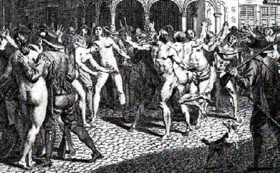Adamites

The Adamites, or Adamians, were adherents of an Early Christian sect that gathered in North Africa in the 2nd, 3rd and 4th centuries. There were later similar sects in Europe. They wore no clothing during their religious services.
Ancient Adamites
The obscure sect, dating probably from the 2nd century, professed to have regained Adam's primeval innocence. Various accounts are given of their origin. Some have thought them to have been an offshoot of the Carpocratian Gnostics, who professed a sensual mysticism and a complete emancipation from the moral law. Theodoret (Haer. Fab., I, 6) held this view of them, and identified them with the licentious sects whose practices are described by Clement of Alexandria. Others, on the contrary, consider them to have been misguided ascetics, who strove to extirpate carnal desires by a return to simpler manners, and by the abolition of marriage.
St. Epiphanius and Augustine of Hippo mention the Adamites by name, and describe their practices. They called their church "Paradise", claiming that its members were re-established in Adam and Eve's state of original innocence. Accordingly, they practiced "holy nudism", rejected the form of marriage as foreign to Eden, saying it would never have existed but for sin, lived in absolute lawlessness, holding that, whatever they did, their actions could be neither good nor bad[1] and stripped themselves naked while engaged in common worship.
Neo-Adamites
Practices similar to those just described appeared in Europe several times in later ages. During the Middle Ages the doctrines of this obscure sect, which did not itself exist long, were revived:[1] in the 13th century in the Netherlands by the Brethren of the Free Spirit and the Taborites in Bohemia, and, in a grosser form, in the fourteenth by the Beghards in Germany. Everywhere they met with firm opposition from the mainstream churches.
The Beghards became the Picards of Bohemia, who took possession of an island in the river Nežárka, and lived communally, practicing social and religious nudity, free love and rejecting marriage and individual ownership of property. Jan Žižka, the Hussite leader, nearly exterminated the sect in 1421.[2] In the following year, the sect was widely spread over Bohemia and Moravia, and especially hated by the Hussites (whom they resembled in hatred toward the hierarchy) because they (the Adamites) rejected transubstantiation, the priesthood and the Supper.[3] The strife between the Adamites and the Taborites is dramatized in Against All, the third part of Otakar Vávra's Hussite film trilogy (1958).[4]
A brief revival of these doctrines took place in Bohemia after 1781, owing to the edict of toleration issued by Emperor Joseph II. The Austrian government suppressed the last remnants of the Neo-Adamites in Bohemia by force in 1849.
See also
References
Citations
- 1 2
 One or more of the preceding sentences incorporates text from a publication now in the public domain: Chisholm, Hugh, ed. (1911). "Adamites". Encyclopædia Britannica. 1 (11th ed.). Cambridge University Press. p. 174.
One or more of the preceding sentences incorporates text from a publication now in the public domain: Chisholm, Hugh, ed. (1911). "Adamites". Encyclopædia Britannica. 1 (11th ed.). Cambridge University Press. p. 174. - ↑ Konstantin von Höfler, Geschichtsquellen Böhmens, I, 414, 431.
- ↑
 Rines, George Edwin, ed. (1920). "Adamites". Encyclopedia Americana.
Rines, George Edwin, ed. (1920). "Adamites". Encyclopedia Americana. - ↑ Hames 2009, pp. 21-.
Sources
-
 This article incorporates text from a publication now in the public domain: Herbermann, Charles, ed. (1913). "Adamites". Catholic Encyclopedia. New York: Robert Appleton.
This article incorporates text from a publication now in the public domain: Herbermann, Charles, ed. (1913). "Adamites". Catholic Encyclopedia. New York: Robert Appleton. - Hames, Peter (2009). Czech and Slovak Cinema: Theme and Tradition. Oxford University Press. ISBN 978-0-7486-8683-4.